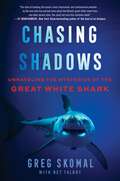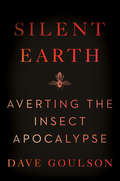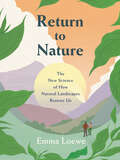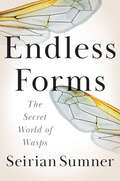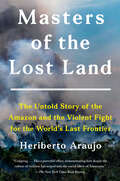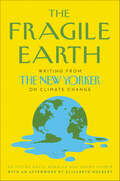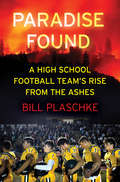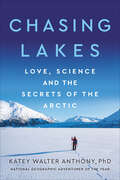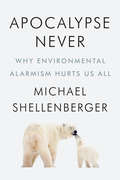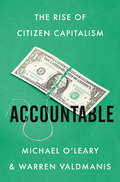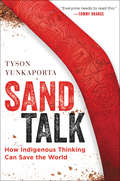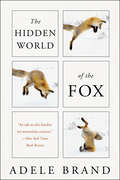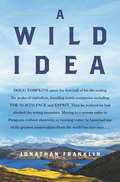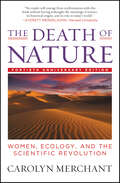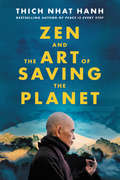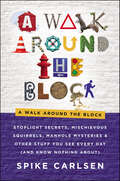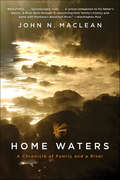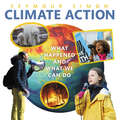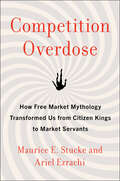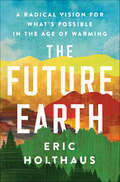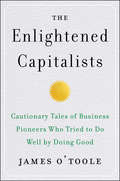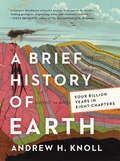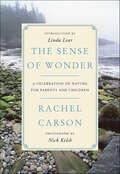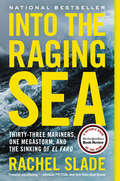- Table View
- List View
Chasing Shadows: My Life Tracking the Great White Shark
by Greg Skomal Ret Talbot“At last: the story of tracking the ocean’s most charismatic and controversial predator, compellingly told by the man who has learned more about the Atlantic great white shark than any other person alive. You must not miss this fantastic book!” —Sy Montgomery, New York Times bestselling author of The Soul of an OctopusDr. Greg Skomal, one of the leading great white shark experts in the country, reveals the true nature of these mysterious apex predators, as well as the fascinating story behind their history and startling resurgence With its quaint villages, local restaurants serving up lobster rolls, and miles and miles of warm, sandy beaches, Cape Cod, Massachusetts, is famous for being America’s carefree seaside getaway. But in August 2012, the first confirmed white shark attack in almost eighty years occurred in the region. As shark sightings quickly began to increase on Cape Cod and elsewhere, and large beachside billboards warning about the growing shark population became a common sight, a boogie boarder died after being attacked by a great white shark in Cape Cod’s shallow waters.What had changed to cause news of human-shark interactions to go from being a rarity to being the new normal? As some citizens called for shark culls, nets, drone surveillance, and other extreme solutions, interactions between local residents and scientists, politicians, and those responsible for public safety became tense and frantic.Dr. Greg Skomal, a shark biologist whose lifelong passion has been to gain a more refined understanding of great white sharks, was at the center of it all. This is the story of the great white shark’s return to the eastern seaboard, told through the life of the scientist who found himself in the oftentimes thankless position of having to balance conservation efforts and the drive to do important science with panic and fear in the court of public opinion. Greg has spent decades on a quest to tag, track, and demystify this animal, using every high- and low-tech method at his disposal, including those he invented, and he frequently comes face-to-face with these shadows of the deep. He leaves no stone unturned in his pursuit of the secrets behind the largely unknown lives of these charismatic creatures and in his duty to solve the intricate puzzle of how humans can coexist alongside them.Chasing Shadows is a too-rare conservation success story about restoring an apex predator to an ecosystem that provides a profound, new understanding of a beast so notoriously fierce that it’s nearly impossible to imagine how vulnerable it truly is.
Silent Earth: Averting the Insect Apocalypse
by Dave Goulson“A terrific book…A thoughtful explanation of how the dramatic decline of insect species and numbers poses a dire threat to all life on earth.” (Booklist, Starred Review)In the tradition of Rachel Carson’s groundbreaking environmental classic Silent Spring, an award-winning entomologist and conservationist explains the importance of insects to our survival, and offers a clarion call to avoid a looming ecological disaster of our own making.Drawing on thirty years of research, Goulson has written an accessible, fascinating, and important book that examines the evidence of an alarming drop in insect numbers around the world. “If we lose the insects, then everything is going to collapse,” he warned in a recent interview in the New York Times—beginning with humans’ food supply. The main cause of this decrease in insect populations is the indiscriminate use of chemical pesticides. Hence, Silent Earth’s nod to Rachel Carson’s classic Silent Spring which, when published in 1962, led to the global banning of DDT. This was a huge victory for science and ecological health at the time.Yet before long, new pesticides just as lethal as DDT were introduced, and today, humanity finds itself on the brink of a new crisis. What will happen when the bugs are all gone? Goulson explores the intrinsic connection between climate change, nature, wildlife, and the shrinking biodiversity and analyzes the harmful impact for the earth and its inhabitants. Meanwhile we have all read stories about hive collapse syndrome affecting honeybee colonies and the tragic decline of monarch butterflies in North America, and more. But it is not too late to arrest this decline, and Silent Earth should be the clarion call. Smart, eye-opening, and essential, Silent Earth is a forceful call to action to save our world, and ultimately, ourselves.Silent Earth includes approximately 20 black-and-white illustrations and charts and graphs.
Return to Nature: The New Science of How Natural Landscapes Restore Us
by Emma LoeweDiscover the new science and ancient wisdom on why nature makes us healthier and happier in body and soul from the co-author of The Spirit Almanac and mindbodygreen’s Senior Sustainability Editor.For centuries, we have known that getting outside is good for us. Yet we have become increasingly disconnected from the earth that nourishes us, with most of us spending 87% of our days indoors. In response, writer and environmentalist Emma Loewe demonstrates the power of nature’s healing properties in a guidebook organized by eight landscapes. In each chapter, you'll find research-backed ways to explore that landscape right now and protect it in the future, so that it can be healthy and nurturing for generations to come. Drawing off modern science and innate wisdom, she uncovers: Why being by the ocean makes you measurably happierHow living near greenery helps you lives longerThe staggering, illuminating statistic that forests can make you more relaxed within 90 seconds of walking among trees.Alongside beautiful four-color illustrations that inspire us all to get outside in big and small ways, this stunning book—more urgent than ever—will appeal to anyone looking to connect with the world around them, whether in their neighborhood park or on a backpacking getaway.
Endless Forms: The Secret World of Wasps
by Seirian Sumner“A book that draws us in to the strange beauty of what we so often run away from.” — Robin Ince, author of The Importance of Being InterestedIn this eye-opening and entertaining work of popular science in the spirit of The Mosquito, Entangled Life, and The Book of Eels, a leading behavioural ecologist transforms our understanding of wasps, exploring these much-maligned insects’ secret world, their incredible diversity and complex social lives, and revealing how they hold our fragile ecosystem in balance.Everyone worries about the collapse of bee populations. But what about wasps? Deemed the gangsters of the insect world, wasps are winged assassins with formidable stings. Conduits of Biblical punishment, provokers of fear and loathing, inspiration for horror movies: wasps are perhaps the most maligned insect on our planet. But do wasps deserve this reputation?Endless Forms opens our eyes to the highly complex and diverse world of wasps. Wasps are 100 million years older than bees; there are ten times more wasp species than there are bees. There are wasps that spend their entire lives sealed inside a fig; wasps that turn cockroaches into living zombies; wasps that live inside other wasps. There are wasps that build citadels that put our own societies to shame, marked by division of labor, rebellions and policing, monarchies, leadership contests, undertakers, police, negotiators, and social parasites. Wasps are nature’s most misunderstood insect: as predators and pollinators, they keep the planet’s ecological balance in check. Wasps are nature’s pest controllers; a world without wasps would be just as ecologically devastating as losing the bees, or beetles, or butterflies.Wasps are diverse and beautiful by every measure, and they are invaluable to planetary health, Professor Sumner reminds us; we’d do well to appreciate them as much as their cuter cousins, the bees.
Masters of the Lost Land: The Untold Story of the Amazon and the Violent Fight for the World's Last Frontier
by Heriberto AraujoIn the tradition of Killers of the Flower Moon, a haunting murder mystery revealing the human story behind one of the most devastating crimes of our time: the ruthless destruction of the Amazon rain forest—and anyone who stands in the wayDeep in the heart of the Amazon, the city of Rondon do Pará, Brazil, lived for decades in the shadow of land barons, or fazendeiros, who maintained control of the region through unscrupulous land grabs and egregious human rights violations. They razed and burned the jungle, expelled small-scale farmers and Indigenous tribes from their lands, and treated their farmhands as slaves—all with impunity. The only true opposition came from Rondon’s small but robust farmworkers’ union, led by the charismatic Dezinho, who fought to put power back into the hands of the people who called the Amazon home. But when Dezinho was assassinated in cold blood, it seemed the farmworkers’ struggle had come to a violent and fruitless end.What no one anticipated was that this event would bring forth an unlikely hero: Dezinho’s widow. Against great odds, and at extreme personal risk, Maria Joel, now a single mother of four young children, used her ingenuity and unwavering support from union members to bring her husband’s killer to account in court. Her campaign gained unexpected momentum, helping to bring international attention to the dire situation in Rondon, from Brazil’s president Lula to international celebrities and civil rights groups.Maria Joel’s fight for justice had far-reaching implications: it unearthed a chilling world of corruption and lawlessness rooted in Brazil’s quest to turn the largest rain forest on earth into an economic frontier. As more details came out, it began to look increasingly likely that Dezinho’s killer, a reluctant and inexperienced gunman, was just one piece of a larger criminal consortium, with ties leading all the way up to one of the region’s most powerful and notorious fazendeiros of all.Featuring groundbreaking revelations and exclusive interviews, this gripping work of narrative nonfiction is the culmination of journalist Heriberto Araujo’s years-long investigation in the heart of the Amazon. Set against the backdrop of appalling deforestation rates and resultant superfires, Masters of the Lost Land vividly reveals the human story behind the loss of—and fierce crusade to protect—one of our greatest resources in the fight against climate change and one of the last wild places on earth.
The Fragile Earth: Writing from The New Yorker on Climate Change
by Elizabeth KolbertA New York Times New & Noteworthy BookOne of the Daily Beast’s 5 Essential Books to Read Before the ElectionA collection of the New Yorker’s groundbreaking reporting from the front lines of climate change—including writing from Bill McKibben, Elizabeth Kolbert, Ian Frazier, Kathryn Schulz, and moreJust one year after climatologist James Hansen first came before a Senate committee and testified that the Earth was now warmer than it had ever been in recorded history, thanks to humankind’s heedless consumption of fossil fuels, New Yorker writer Bill McKibben published a deeply reported and considered piece on climate change and what it could mean for the planet. At the time, the piece was to some speculative to the point of alarmist; read now, McKibben’s work is heroically prescient. Since then, the New Yorker has devoted enormous attention to climate change, describing the causes of the crisis, the political and ecological conditions we now find ourselves in, and the scenarios and solutions we face. The Fragile Earth tells the story of climate change—its past, present, and future—taking readers from Greenland to the Great Plains, and into both laboratories and rain forests. It features some of the best writing on global warming from the last three decades, including Bill McKibben’s seminal essay “The End of Nature,” the first piece to popularize both the science and politics of climate change for a general audience, and the Pulitzer Prize–winning work of Elizabeth Kolbert, as well as Kathryn Schulz, Dexter Filkins, Jonathan Franzen, Ian Frazier, Eric Klinenberg, and others. The result, in its range, depth, and passion, promises to bring light, and sometimes heat, to the great emergency of our age.
Paradise Found: A High School Football Team's Rise from the Ashes
by Bill Plaschke"Friday Night Lights meets Unbroken." —Tony Reali | "One of the most profound stories you will ever read." —Ian O'Connor | "Plaschke delivers a masterpiece." —Jeff PearlmanFrom L.A. Times columnist and ESPN Around the Horn panelist Bill Plaschke, a story of tragedy, triumph, and the remarkable power of high school football in one small California townOn November 8, 2018, the Camp Fire ravaged the town of Paradise, California. The fire, which burned up to 80 acres per minute, killed 86 people, and nearly every building and home in the town was reduced to ashes. In a single day, Paradise, a proud working-class town in the foothills of the Sierra Nevadas, saw its population fall from 25,000 to 2,000.The Paradise High football team had long been the town’s source of joy and inspiration. But in the wake of the fire, their season was abruptly cancelled on the eve of the playoffs. Their championship hopes were gone. Their program’s survival seemed doubtful—it wasn’t even clear whether Paradise High would continue to exist.Coach Rick Prinz had planned to retire that year after guiding the Paradise High Bobcats for two decades. But after the fire forever altered his beloved town, he realized he couldn’t walk away. What ensued was the challenge of a lifetime. Of the 104 football players at Paradise, 95 had lost their homes. His varsity squad, which had stood 76 strong the previous season, was down to 22. Most of those who remained were homeless, sleep-deprived, lost. On the first day of spring practice, on a debris-ridden patch of grass at nearby Chico Airport, Prinz’s team didn’t even have a football. It was the humble beginning to a memorable journey.Bill Plaschke, longtime columnist for the Los Angeles Times, followed the Paradise Bobcats throughout a most remarkable season. In this gripping, deeply-reported story of tragedy and resilience, Plaschke reveals the unique power of sports to unite, to inspire, and to heal. As the Paradise players fought to rebuild their broken lives, they found strength in the support of their teammates—and as football returned to Paradise, so, too, did the spirit of the town itself.
Chasing Lakes: Love, Science, and the Secrets of the Arctic
by Katey Walter AnthonyAn aquatic ecologist and permafrost scientist recalls her captivating adventures across the Arctic studying climate change, her quest to find belonging and family, and her journey of faith in a world of science in this poignant, eye-opening, and hopeful memoir in the spirit of Lab Girl, Educated, and Finding the Mother Tree.Katey Walter Anthony’s enchantment with lakes began when she was growing up amid the Sierra Nevada mountains. Today, her love for these bodies of water have taken her to the deepest reaches of Alaska and Siberia, where she is undertaking pioneering research on methane emissions. Chasing Lakes is her story: one-part adventure—complete with shipwrecks and treacherous treks through Arctic storms by helicopter, snowmobile, and foot to measure greenhouse gases—part coming-of-age tale, as she searches for belonging in the wake of a broken childhood, and part spiritual quest to find a wholeness science cannot fill.Somewhere between the remote, frozen landscapes of Siberia and her rough cabin in Alaska, she discovers her spiritual and emotional home when she meets Peter, a bright and humble Minnesota farmer who reinvigorates her faith and helps ground her. Yet finding love and fulfillment brings its own challenges. The closer she gets to having the family she’s always wanted, the further she’s pushed from the important field work that is her passion.Chasing Lakes is a chronicle of a woman seeking truth, adventure, scientific discovery, family, love, and grace. Both an eye-opening look from the frontlines of the climate crisis and an intimate portrait of a brilliant scientist, Chasing Lakes is memoir writing at its finest: beautiful, complex, revelatory, and moving.
Apocalypse Never: Why Environmental Alarmism Hurts Us All
by Michael ShellenbergerClimate change is real but it’s not the end of the world. It is not even our most serious environmental problem. Michael Shellenberger has been fighting for a greener planet for decades. He helped save the world’s last unprotected redwoods. He co-created the predecessor to today’s Green New Deal. And he led a successful effort by climate scientists and activists to keep nuclear plants operating, preventing a spike of emissions.But in 2019, as some claimed “billions of people are going to die,” contributing to rising anxiety, including among adolescents, Shellenberger decided that, as a lifelong environmental activist, leading energy expert, and father of a teenage daughter, he needed to speak out to separate science from fiction.Despite decades of news media attention, many remain ignorant of basic facts. Carbon emissions peaked and have been declining in most developed nations for over a decade. Deaths from extreme weather, even in poor nations, declined 80 percent over the last four decades. And the risk of Earth warming to very high temperatures is increasingly unlikely thanks to slowing population growth and abundant natural gas. Curiously, the people who are the most alarmist about the problems also tend to oppose the obvious solutions. What’s really behind the rise of apocalyptic environmentalism? There are powerful financial interests. There are desires for status and power. But most of all there is a desire among supposedly secular people for transcendence. This spiritual impulse can be natural and healthy. But in preaching fear without love, and guilt without redemption, the new religion is failing to satisfy our deepest psychological and existential needs.
Accountable: The Rise of Citizen Capitalism
by Michael O'Leary Warren Valdmanis“More than ever before, this is the book our economy needs.” – Dr. Rajiv Shah, president of the Rockefeller Foundation“Unwilling to settle for easy answers or superficial changes, O’Leary and Valdmanis push us all to ask more of our economic system.” – Senator Michael F. BennetThis provocative book takes us inside the fight to save capitalism from itself.Corporations are broken, reflecting no purpose deeper than profit. But the tools we are relying on to fix them—corporate social responsibility, divestment, impact investing, and government control—risk making our problems worse.With lively storytelling and careful analysis, O’Leary and Valdmanis cut through the tired dogma of current economic thinking to reveal a hopeful truth: If we can make our corporations accountable to a deeper purpose, we can make capitalism both prosperous and good.What happens when the sustainability-driven CEO of Unilever takes on the efficiency-obsessed Warren Buffett? Does Kellogg’s—a company founded to serve a healthy breakfast—have a sacred duty to sell sugary cereal if that’s what maximizes profit? For decades, government has tried to curb CEO pay but failed. Why? Can Harvard students force the university to divest from oil and gas? Does it even matter if they do?O’Leary and Valdmanis, two iconoclastic investors, take us on a fast-paced insider’s journey that will change the way we look at corporations. Likely to spark controversy among cynics and dreamers alike, this book is essential reading for anyone with a stake in reforming capitalism—which means all of us.
Sand Talk: How Indigenous Thinking Can Save the World
by Tyson YunkaportaA paradigm-shifting book in the vein of Sapiens that brings a crucial Indigenous perspective to historical and cultural issues of history, education, money, power, and sustainability—and offers a new template for living.As an indigenous person, Tyson Yunkaporta looks at global systems from a unique perspective, one tied to the natural and spiritual world. In considering how contemporary life diverges from the pattern of creation, he raises important questions. How does this affect us? How can we do things differently?In this thoughtful, culturally rich, mind-expanding book, he provides answers. Yunkaporta’s writing process begins with images. Honoring indigenous traditions, he makes carvings of what he wants to say, channeling his thoughts through symbols and diagrams rather than words. He yarns with people, looking for ways to connect images and stories with place and relationship to create a coherent world view, and he uses sand talk, the Aboriginal custom of drawing images on the ground to convey knowledge. In Sand Talk, he provides a new model for our everyday lives. Rich in ideas and inspiration, it explains how lines and symbols and shapes can help us make sense of the world. It’s about how we learn and how we remember. It’s about talking to everyone and listening carefully. It’s about finding different ways to look at things.Most of all it’s about a very special way of thinking, of learning to see from a native perspective, one that is spiritually and physically tied to the earth around us, and how it can save our world.Sand Talk include 22 black-and-white illustrations that add depth to the text.
The Hidden World of the Fox
by Adele BrandDiscover the hidden world of the fox, as beautifully revealed by an acclaimed ecologist who has studied foxes for two decades across four continents “An ode to this familiar yet mysterious creature. … The sight of foxes can lift Brand's prose into poetry. ... By turns lyrical, salty, funny and scholarly.” —New York Times Book ReviewThe fox. For thousands of years myth and folklore have celebrated its cunning intelligence. Today the red fox is the nature’s most populous carnivore, its dancing orange tail a common sight in backyards. Yet who is this wild neighbor, truly? How do we negotiate this uneasy new chapter of an ancient relationship? Join British ecologist Adele Brand on a journey to discover the surprising secrets of the fabled fox, the familiar yet enigmatic creature that has adapted to the human world with astonishing—some say, unsettling—success.Brand has studied foxes for twenty years across four continents—from the Yucatán rainforest to India’s remote Thar Desert, from subarctic Canada to metropolitan London. Her observations have convinced her that the fox is arguably the most modern of all wildlife, uniquely suited to survival in the rapidly expanding urban/wild interface. Blending cutting-edge science, cultural anthropology, and intimate personal storytelling drawn from her own remarkable fieldwork, The Hidden World of the Fox is Brand’s rich and revelatory portrait of the extraordinary animal she has devoted her life to understanding.
A Wild Idea
by Jonathan FranklinWHY WOULD A SAN FRANCISCO ENTREPRENEUR SELL HIS COMPANY, FLY TO THE ENDS OF THE EARTH, INVEST MILLIONS RESTORING PARADISE, THEN FIGHT LIKE HELL TO GIVE IT ALL AWAY? In 1991, Doug Tompkins left his luxury life in San Francisco and flew 6,500 miles south to a shack in Patagonia that his friends nicknamed Hobbit House. Mounted on wooden skids that allowed oxen to drag it through the cow fields, Hobbit House had for refrigerator a metal box chilled from the icy cold winds off the glacier. Rainwater dripped from a rooftop barrel into the rustic kitchen. Earlier tenants include a sheepherder with little more than his dogs and a rifle. Instead of the Golden Gate Bridge, Tompkins now stared at Volcano Michinmahuida, blanketed in snow and prowled by mountain lions the size of small tigers. Shielded by wilderness, waterfalls and tucked into a remote forest with three times the rainfall of Seattle, Tompkins plotted his counterattack against corporate capitalism. As founder of Esprit and The North Face he had “made things nobody needed.” Now he declared it was time to “pay my rent for living on this planet.” Could he undo the environmental damage produced by his prodigious clothes manufacturing? Could he launch a new brand, one that promoted environmental conservation, preservation and restoration? In Patagonia, Tompkins adored his pioneer existence. All his belongings fit in a single duffel bag. When hungry, he fished from his front yard and harvested vegetables from a greenhouse. Tompkins kayaked along the rivers, ice-climbed glaciers, and waited until the ocean storms reached a frothy peak to pilot his wood-hulled crab boat into the raging waves of the Pacific. Within a hundred miles there were virtually no roads and his old farm was accessible to the occasional fishing boat and a battered airstrip. Flying his small plane for hundreds of hours, he explored. The average plot of land is 10,000 acres and the price per acre is as little as US$25. It was all for sale and about to be destroyed by clearcut logging. Zooming over treetops and around mountain peaks, Tompkins flew inside tight canyons and gaped at the singular beauty: active volcanoes, gliding condors, forests never logged, rivers never dammed—all so undisturbed, so exquisitely designed, without a single flaw. Could he protect this wild beauty? Place a frame around this perfect creation? For the ensuing quarter century that dream, that obsession became his life. Only in death did it become his legacy.
The Death of Nature: Women, Ecology, and the Scientific Revolution
by Carolyn MerchantUPDATED 40TH ANNIVERSARY EDITION WITH 2020 PREFACEAn examination of the Scientific Revolution that shows how the mechanistic world view of modern science has sanctioned the exploitation of nature, unrestrained commercial expansion, and a new socioeconomic order that subordinates women.
Zen and the Art of Saving the Planet
by Thich Nhat Hanh“When you wake up and you see that the Earth is not just the environment, the Earth is us, you touch the nature of interbeing. And at that moment you can have real communication with the Earth… We have to wake up together. And if we wake up together, then we have a chance. Our way of living our life and planning our future has led us into this situation. And now we need to look deeply to find a way out, not only as individuals, but as a collective, a species.”-- Thich Nhat HanhWe face a potent intersection of crises: ecological destruction, rising inequality, racial injustice, and the lasting impacts of a devastating pandemic. The situation is beyond urgent. To face these challenges, we need to find ways to strengthen our clarity, compassion, and courage to act.Beloved Zen Master Thich Nhat Hanh is blazingly clear: there’s one thing we all have the power to change, which can make all the difference, and that is our mind. Our way of looking, seeing, and thinking determines every choice we make, the everyday actions we take or avoid, how we relate to those we love or oppose, and how we react in a crisis.Mindfulness and the radical insights of Zen meditation can give us the strength and clarity we need to help create a regenerative world in which all life is respected. Filled with Thich Nhat Hanh’s inspiring meditations, Zen stories and experiences from his own activism, as well as commentary from Sister True Dedication, one of his students Zen and the Art of Saving the Planet shows us a new way of seeing and living that can bring healing and harmony to ourselves, our relationships, and the Earth.
A Walk: Stoplight Secrets, Mischievous Squirrels, Manhole Mysteries & Other Stuff You See Every Day (And Know Nothing About)
by Spike Carlsen“Carlsen sees a world of wonder hiding in plain sight and may just change how you look at the world around you.” - TODAY ShowA simple walk around the block set journalist Spike Carlsen, bestselling author of A Splintered History of Wood, off to investigate everything he could about everything we take for granted in our normal life—from manhole covers and recycling bins to bike lanes and stoplights.In this celebration of the seemingly mundane, Carlsen opens our eyes to the engineering marvels, human stories, and natural wonders right outside our front door. He guides us through the surprising allure of sewers, the intricacies of power plants, the extraordinary path of an everyday letter, and the genius of recycling centers—all the while revealing that this awesome world isn’t just a spectator sport.Engaging as it is endearing, A Walk Around the Block will change the way you see things in your everyday life. Join Carlsen as he strolls through the trash museum of New York City, explores the quirky world of squirrels, pigeons, and roadkill, and shows us how understanding stoplights, bike lanes, and fine art of walking can add years to our lives. In the end, he brings a sense of wonder into your average walk around the block, wherever you are. Guaranteed.
Home Waters: A Chronicle of Family and a River
by John N. Maclean“Beautiful. ... A lyrical companion to his father’s classic, A River Runs through It, chronicling their family’s history and bond with Montana’s Blackfoot River.” —Washington PostA "poetic" and "captivating" (Publishers Weekly) memoir about the power of place to shape generations, Home Waters is John N. Maclean's remarkable chronicle of his family's century-long love affair with Montana's majestic Blackfoot River, the setting for his father's classic novella, A River Runs through It. Maclean returns annually to the simple family cabin that his grandfather built by hand, still in search of the trout of a lifetime. When he hooks it at last, decades of longing promise to be fulfilled, inspiring John, reporter and author, to finally write the story he was born to tell. A book that will resonate with everyone who feels deeply rooted to a landscape, Home Waters is a portrait of a family who claimed a river, from one generation to the next, of how this family came of age in the 20th century and later as they scattered across the country, faced tragedy and success, yet were always drawn back to the waters that bound them together. Here are the true stories behind the beloved characters fictionalized in A River Runs through It, including the Reverend Maclean, the patriarch who introduced the family to fishing; Norman, who balanced a life divided between literature and the tug of the rugged West; and tragic yet luminous Paul (played by Brad Pitt in Robert Redford’s film adaptation), whose mysterious death has haunted the family and led John to investigate his uncle’s murder and reveal new details in these pages.A universal story about nature, family, and the art of fly fishing, Maclean’s memoir beautifully captures the inextricable ways our personal histories are linked to the places we come from—our home waters. Featuring twelve wood engravings by Wesley W. Bates and a map of the Blackfoot River region.
Climate Action: What Happened and What We Can Do
by Seymour SimonMeet the young activists who are using their voices and minds to fight climate change. Did you know that the past five years have been the hottest ever recorded? Or that over seven million people participated in the global Climate Strike? We’re facing a very real problem, but there’s hope. Everyone is affected by climate change. Reading Climate Action: What Happened and What We Can Do is the perfect introduction not only to the dramatic effects of climate change, but to the solutions. Learn how our behavior and actions have led us to this point, hear from kids around the world dealing with extreme storms, wildfires, and sea level rise, and discover what scientists, youth activists, and ordinary citizens are doing to protect their communities. Divided into eight sections for easy browsing and with over fifty photographs, captions, charts, and graphs, this nonfiction book is an excellent choice to share in the classroom and for homeschooling for kids ages 6 and up. Also includes a glossary to supplement the text, author’s note, and index. Climate Action is the latest of Seymour Simon’s nonfiction science books. His books are regularly honored by the National Science Teacher's Association.
Competition Overdose: How Free Market Mythology Transformed Us from Citizen Kings to Market Servants
by Maurice E. Stucke Ariel EzrachiStucke and Ezrachi’s analysis of the nature of competition is refreshingly non-ideological and counterintuitive. Their idea that competition can be either toxic or noble—all depending on how governments structure markets—is something so clear that it’s remarkable it’s taken us decades to recognize the wisdom of it. This is a must-read for anyone interested in how to use public policy to harness the competitive drive for the public good. — Chris Hughes, cofounder of FacebookStucke and Ezrachi show us the important differences between destructive and noble competition and what we can do to pursue a more just and prosperous world. This book changes how you will view the role of the market in our economy and society at large. — Spencer Weber Waller, director of the Institute for Consumer Antitrust Studies and law professor at Loyola University ChicagoEntertaining and thought-provoking, Competition Overdose fiercely articulates the raw, hard truth behind the toxic aspects of competition. — Tommaso Valletti, professor of economics at Imperial College London and Chief Competition Economist (2016–2019), European CommissionCompetition Overdose is probably the most important book to be published on the subject since The Antitrust Paradox hit the bookshelves in 1978. It is destined to transform how governments across the world think about the role competition in domestic and international policy for decades to come. Stucke and Ezrachi are the new rock stars of competition policy. — Ali Nikpay, partner at Gibson Dunn & CrutcherAnything, in the wrong dosage, can be poisonous. Competition Overdose takes a sacred cow of contemporary western thought—that ‘more competition is always good’—and reveals that while competition can be noble, it can also be toxic. An engaging and compelling read that will make you think differently about situations we all deal with every day. — Tim Wu, professor at Columbia Law School, contributing opinion writer for the New York Times, and author of The Master Switch and The Attention MerchantsA must-read for anyone concerned about the future of our economy and society, Competition Overdose provides a no-nonsense analysis of how toxic competition can be bad for competitors, consumers, workers, and society overall. The authors highlight the abuses of this ideology and remind us that we, as citizens and consumers, can exercise our power by choosing products, based on our values. — Monique Goyens, director general of BEUC, The European Consumer OrganisationThis beautifully written book helps us rethink economic principles from the ground up. As any good chemist knows, what can be helpful or harmless in small doses is deadly in excess. While technocrats push competition as a cure to all economic ailments, Stucke and Ezrachi deliver a dose of reality: cutthroat schemes to kneecap rivals, manipulate customers, and exploit workers harm far more than they help. Read this book for a brilliant account of the proper place of competition (and ethics) in society. — Frank Pasquale, law professor at University of Maryland and author of The Black Box SocietyStucke and Ezrachi examine a multitude of perversities in today’s society—colleges striving to recruit applicants they likely will reject, supermarkets stocking hundreds of varieties of jam, travel deals stuffed with hidden fees—and provide a unifying explanation: a misalignment of competition. Their book illuminates how competition can go wrong, and how individuals, businesses, and the government can set it right. — Jonathan Levin, dean of Stanford Graduate School of BusinessIs more competition the solution to all our societal problems? Stucke and Ezrachi persuasively say: No, it depends; sometimes we need to rein in markets because they prod
The Future Earth: A Radical Vision for What's Possible in the Age of Warming
by Eric HolthausThe first hopeful book about climate change, The Future Earth shows readers how to reverse the short- and long-term effects of climate change over the next three decades.The basics of climate science are easy. We know it is entirely human-caused. Which means its solutions will be similarly human-led. In The Future Earth, leading climate change advocate and weather-related journalist Eric Holthaus (“the Rebel Nerd of Meteorology”—Rolling Stone) offers a radical vision of our future, specifically how to reverse the short- and long-term effects of climate change over the next three decades. Anchored by world-class reporting, interviews with futurists, climatologists, biologists, economists, and climate change activists, it shows what the world could look like if we implemented radical solutions on the scale of the crises we face. What could happen if we reduced carbon emissions by 50 percent in the next decade?What could living in a city look like in 2030?How could the world operate in 2040, if the proposed Green New Deal created a 100 percent net carbon-free economy in the United States?This is the book for anyone who feels overwhelmed by the current state of our environment. Hopeful and prophetic, The Future Earth invites us to imagine how we can reverse the effects of climate change in our own lifetime and encourages us to enter a deeper relationship with the earth as conscientious stewards and to re-affirm our commitment to one another in our shared humanity.
The Enlightened Capitalists: Cautionary Tales of Business Pioneers Who Tried to Do Well by Doing Good
by James O'TooleAn expert on ethical leadership analyzes the complicated history of business people who tried to marry the pursuit of profits with virtuous organizational practices—from British industrialist Robert Owen to American retailer John Cash Penney and jeans maker Levi Strauss to such modern-day entrepreneurs Anita Roddick and Tom Chappell. <P><P>Today’s business leaders are increasingly pressured by citizens, consumers, and government officials to address urgent social and environmental issues. Although some corporate executives remain deaf to such calls, over the last two centuries, a handful of business leaders in America and Britain have attempted to create business organizations that were both profitable and socially responsible. In The Enlightened Capitalists, James O’Toole tells the largely forgotten stories of men and women who adopted forward-thinking business practices designed to serve the needs of their employees, customers, communities, and the natural environment. They wanted to prove that executives didn’t have to make trade-offs between profit and virtue. <P><P>Combining a wealth of research and vivid storytelling, O’Toole brings life to historical figures like William Lever, the inventor of bar soap who created the most profitable company in Britain and used his money to greatly improve the lives of his workers and their families. Eventually, he lost control of the company to creditors who promptly terminated the enlightened practices he had initiated—the fate of many idealistic capitalists. <P><P>As a new generation attempts to address social problems through enlightened organizational leadership, O’Toole explores a major question being posed today in Britain and America: Are virtuous corporate practices compatible with shareholder capitalism?
A Brief History of Earth: Four Billion Years in Eight Chapters
by Andrew H. Knoll“A sublime chronicle of our planet." –Booklist, STARRED reviewA primer for every Earth resident, by Harvard’s acclaimed geologistHow well do you know the ground beneath your feet? Odds are, where you’re standing was once cooking under a roiling sea of lava, crushed by a towering sheet of ice, rocked by a nearby meteor strike, or perhaps choked by poison gases, drowned beneath ocean, perched atop a mountain range, or roamed by fearsome monsters. Probably most or even all of the above. The story of our home planet and the organisms spread across its surface is far more spectacular than any Hollywood blockbuster, filled with enough plot twists to rival a bestselling thriller. But only recently have we begun to piece together the whole mystery into a coherent narrative. Drawing on his decades of field research and up-to-the-minute understanding of the latest science, renowned geologist Andrew H. Knoll delivers a rigorous yet accessible biography of Earth, charting our home planet's epic 4.6 billion-year story. Placing twenty first-century climate change in deep context, A Brief History of Earth is an indispensable look at where we’ve been and where we’re going.Features original illustrations depicting Earth history and nearly 50 figures (maps, tables, photographs, graphs).
How a City Works (Let's-Read-and-Find-Out Science 2)
by D. J. WardRead and find out about how cities work in this colorfully illustrated nonfiction picture book.Millions of people live in cities around the world, but have you ever wondered how cities work? All those people need clean water to drink, a safe place to live, and a way to get all around the city. How do you take care of all those people’s needs? Read and find out all about the systems a city has to help keep everyone safe, healthy, and happy.This book on city systems will appeal to the young civil engineer. How a City Works is filled with fun, accurate art, and includes tons of information. For example, it answers the question: Where does all the electricity needed to make a city run come from? How a City Works covers water treatment, power, sewage, recycling, and transportation.How a City Works comes packed with visual aids like charts, sidebars, an infographic, and a funny, hands-on activity—how to clean up dirty “sewage” water, using puffed rice cereal, raisins, hot chocolate mix, and coffee filters.This is a clear and appealing science book for early elementary age kids, both at home and in the classroom. It's a Level 2 Let's-Read-and-Find-Out, which means the book explores more challenging concepts for children in the primary grades. The 100+ titles in this leading nonfiction series are:hands-on and visualacclaimed and trustedgreat for classroomsTop 10 reasons to love LRFOs:Entertain and educate at the same timeHave appealing, child-centered topicsDevelopmentally appropriate for emerging readersFocused; answering questions instead of using survey approachEmploy engaging picture book quality illustrationsUse simple charts and graphics to improve visual literacy skillsFeature hands-on activities to engage young scientistsMeet national science education standardsWritten/illustrated by award-winning authors/illustrators & vetted by an expert in the fieldOver 130 titles in print, meeting a wide range of kids' scientific interestsBooks in this series support the Common Core Learning Standards, Next Generation Science Standards, and the Science, Technology, Engineering, and Math (STEM) standards. Let's-Read-and-Find-Out is the winner of the American Association for the Advancement of Science/Subaru Science Books & Films Prize for Outstanding Science Series.
The Sense of Wonder: A Celebration of Nature for Parents and Children
by Rachel CarsonFirst published a half-century ago, Rachel Carson's award-winning The Sense of Wonder remains the classic guide to introducing children to the marvels of natureIn 1955, acclaimed conservationist Rachel Carson—author of Silent Spring—began work on an essay that she would come to consider one of her life’s most important projects. Her grandnephew, Roger Christie, had visited Carson that summer at her cottage in Maine, and together they had wandered the surrounding woods and tide pools. Teaching Roger about the natural wonders around them, Carson began to see them anew herself, and wanted to relate that same magical feeling to others who might hope to introduce a child to the beauty of nature. “If a child is to keep alive his inborn sense of wonder,” writes Carson, “he needs the companionship of at least one adult who can share it, rediscovering with him the joy, excitement and mystery of the world we live in.”Now available in paperback, The Sense of Wonder is a timeless volume that will be passed on from generation to generation, as treasured as the memory of an early-morning walk when the song of a whippoorwill was heard as if for the first time. Featuring serene color photographs from renowned photographer Nick Kelsh, “this beautifully illustrated edition makes a fine gift for new and prospective mothers and fathers” (Gregory McNamee), and helps us all to tap into the extraordinary power of the natural world.
Into the Raging Sea: Thirty-Three Mariners, One Megastorm, and the Sinking of El Faro
by Rachel SladeOn October 1, 2015, Hurricane Joaquin barreled into the Bermuda Triangle and swallowed the container ship El Faro whole, resulting in the worst American shipping disaster in thirty-five years. No one could fathom how a vessel equipped with satellite communications, a sophisticated navigation system, and cutting-edge weather forecasting could suddenly vanish—until now. <p><p> Relying on hundreds of exclusive interviews with family members and maritime experts, as well as the words of the crew members themselves—whose conversations were captured by the ship’s data recorder—journalist Rachel Slade unravels the mystery of the sinking of El Faro. As she recounts the final twenty-four hours onboard, Slade vividly depicts the officers’ anguish and fear as they struggled to carry out Captain Michael Davidson’s increasingly bizarre commands, which, they knew, would steer them straight into the eye of the storm. Taking a hard look at America's aging merchant marine fleet, Slade also reveals the truth about modern shipping—a cut-throat industry plagued by razor-thin profits and ever more violent hurricanes fueled by global warming. <p> A richly reported account of a singular tragedy, Into the Raging Sea takes us into the heart of an age-old American industry, casting new light on the hardworking men and women who paid the ultimate price in the name of profit.
